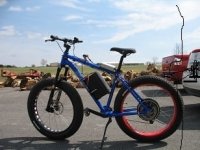ebikedelight
1 kW
- Joined
- Dec 25, 2014
- Messages
- 307
I ordered 8 aluminum heat sinks with heat dissipation fins - the heat sinks are 6" long .
I first attached them directly to the face of each side of the hub motor using a small amount of heat conductive adhesive, towards the outer edges near the copper windings where most of the heat originates. I cut each heatsink down from 6 " to 3 " in length
The right side, I attached 4 of the heatsinks at the 12 - 3 - 6 - 9 o clock positions..the left side I attached 4 of the heatsinks
at the 2- 5 -8 -11 o clock positions.
I then took the ebike out on the dirt trails which normally gets the motor side casings hot to the point that its uncomfortable to hold my hand on it for more then 5 seconds. The heat sinks dissipated enough heat to allow me to hold my hand on the motor without discomfort , but I could still tell the motor was hotter then I wanted.
I came home, took the heat sinks off and then drilled several 1" holes exactly where each heat sink strip had been placed earlier and then reattached the heatsinks over thos holes. I thought the cooling effect would be greater if the heat from the inside of the motor, did not have to first go thru the aluminum side cover , then go thru the aluminum heat sink ....but
only have to go thru the heat sink to reach the cooling effects of the outside air. This was a success. I did the same run on the dirt trails, and the motor was only slightly warm .
This was a win win situation, in that the holes I made in both side covers, allows the heat to dissipate thru the aluminum heat sinks that cover the holes , but ensure that no dirt, water, humidity can enter the holes which are covered by the heat sinks .
This worked so well, I would imagine that eventually, manufacturers of hub motors will apply it to the design of their products. The aluminum heat sinks with fins, allow much better heat dissipation when they are used as the only barrier between the heat of the inside of the motor and the coolness of the outside air/ wind chill effects as the ebike is in motion.
I first attached them directly to the face of each side of the hub motor using a small amount of heat conductive adhesive, towards the outer edges near the copper windings where most of the heat originates. I cut each heatsink down from 6 " to 3 " in length
The right side, I attached 4 of the heatsinks at the 12 - 3 - 6 - 9 o clock positions..the left side I attached 4 of the heatsinks
at the 2- 5 -8 -11 o clock positions.
I then took the ebike out on the dirt trails which normally gets the motor side casings hot to the point that its uncomfortable to hold my hand on it for more then 5 seconds. The heat sinks dissipated enough heat to allow me to hold my hand on the motor without discomfort , but I could still tell the motor was hotter then I wanted.
I came home, took the heat sinks off and then drilled several 1" holes exactly where each heat sink strip had been placed earlier and then reattached the heatsinks over thos holes. I thought the cooling effect would be greater if the heat from the inside of the motor, did not have to first go thru the aluminum side cover , then go thru the aluminum heat sink ....but
only have to go thru the heat sink to reach the cooling effects of the outside air. This was a success. I did the same run on the dirt trails, and the motor was only slightly warm .
This was a win win situation, in that the holes I made in both side covers, allows the heat to dissipate thru the aluminum heat sinks that cover the holes , but ensure that no dirt, water, humidity can enter the holes which are covered by the heat sinks .
This worked so well, I would imagine that eventually, manufacturers of hub motors will apply it to the design of their products. The aluminum heat sinks with fins, allow much better heat dissipation when they are used as the only barrier between the heat of the inside of the motor and the coolness of the outside air/ wind chill effects as the ebike is in motion.


